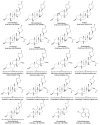Antimicrobial Compounds from Skin Secretions of Species That Belong to the Bufonidae Family
- PMID: 36828459
- PMCID: PMC9968139
- DOI: 10.3390/toxins15020145
Antimicrobial Compounds from Skin Secretions of Species That Belong to the Bufonidae Family
Abstract
Skin secretions of toads are a complex mixture of molecules. The substances secreted comprise more than 80 different compounds that show diverse pharmacological activities. The compounds secreted through skin pores and parotid glands are of particular interest because they help toads to endure in habitats full of pathogenic microbes, i.e., bacteria, fungi, viruses, and protozoa, due to their content of components such as bufadienolides, alkaloids, and antimicrobial peptides. We carried out an extensive literature review of relevant articles published until November 2022 in ACS Publications, Google Scholar, PubMed, and ScienceDirect. It was centered on research addressing the biological characterization of the compounds identified in the species of genera Atelopus, Bufo, Duttaphrynus, Melanophryniscus, Peltopryne, Phrynoidis, Rhaebo, and Rhinella, with antibacterial, antifungal, antiviral, and antiparasitic activities; as well as studies performed with analogous compounds and skin secretions of toads that also showed these activities. This review shows that the compounds in the secretions of toads could be candidates for new drugs to treat infectious diseases or be used to develop new molecules with better properties from existing ones. Some compounds in this review showed activity against microorganisms of medical interest such as Staphylococcus aureus, Escherichia coli, Bacillus subtilis, Coronavirus varieties, HIV, Trypanosoma cruzi, Leishmania chagasi, Plasmodium falciparum, and against different kinds of fungi that affect plants of economic interest.
Keywords: antifungal; antimicrobial peptides; antiprotozoal; antiviral; family Bufonidae; skin secretion.
Conflict of interest statement
The authors declare no conflict of interest.
Figures


Similar articles
-
Antimicrobial Secretions of Toads (Anura, Bufonidae): Bioactive Extracts and Isolated Compounds against Human Pathogens.Antibiotics (Basel). 2020 Nov 26;9(12):843. doi: 10.3390/antibiotics9120843. Antibiotics (Basel). 2020. PMID: 33255881 Free PMC article. Review.
-
Toxins and pharmacologically active compounds from species of the family Bufonidae (Amphibia, Anura).J Ethnopharmacol. 2017 Feb 23;198:235-254. doi: 10.1016/j.jep.2016.12.021. Epub 2016 Dec 27. J Ethnopharmacol. 2017. PMID: 28034659 Review.
-
Bufadienolides from the Skin Secretions of the Neotropical Toad Rhinella alata (Anura: Bufonidae): Antiprotozoal Activity against Trypanosoma cruzi.Molecules. 2021 Jul 12;26(14):4217. doi: 10.3390/molecules26144217. Molecules. 2021. PMID: 34299492 Free PMC article.
-
Biological activities of skin and parotoid gland secretions of bufonid toads (Bufo bufo, Bufo verrucosissimus and Bufotes variabilis) from Turkey.Biomed Pharmacother. 2016 May;80:298-303. doi: 10.1016/j.biopha.2016.03.034. Epub 2016 Apr 2. Biomed Pharmacother. 2016. PMID: 27133069
-
Differences and similarities among parotoid macrogland secretions in South American toads: a preliminary biochemical delineation.ScientificWorldJournal. 2013 Apr 30;2013:937407. doi: 10.1155/2013/937407. Print 2013. ScientificWorldJournal. 2013. PMID: 23737734 Free PMC article.
Cited by
-
Pharmacological insights and role of bufalin (bufadienolides) in inflammation modulation: a narrative review.Inflammopharmacology. 2024 Oct;32(5):3057-3077. doi: 10.1007/s10787-024-01517-9. Epub 2024 Jul 16. Inflammopharmacology. 2024. PMID: 39012431 Review.
-
Immunohistochemical Characterization of Langerhans Cells in the Skin of Three Amphibian Species.Biology (Basel). 2024 Mar 23;13(4):210. doi: 10.3390/biology13040210. Biology (Basel). 2024. PMID: 38666822 Free PMC article.
-
Fabrication and Characterization of Buforin I-Loaded Electrospun Chitosan/Polyethylene Oxide Nanofibrous Membranes with Antimicrobial Activity for Food Packing Applications.Polymers (Basel). 2025 Feb 19;17(4):549. doi: 10.3390/polym17040549. Polymers (Basel). 2025. PMID: 40006211 Free PMC article.
References
-
- AmphibiaWeb AmphibiaWeb<https://Amphibiaweb.Org> University of California, Berkeley, CA, USA. [(accessed on 1 November 2022)]. Available online: https://amphibiaweb.org/lists/Bufonidae.shtml.
-
- Frost D Amphibian Species of the World: An Online Reference (Version 6) [(accessed on 1 November 2022)]. Available online: https://amphibiansoftheworld.amnh.org/Amphibia/Anura/Bufonidae.
-
- Stewart M.M. Biology of Amphibians. William E. Duellman, Linda Trueb. Q. Rev. Biol. 1994;69:670. doi: 10.1086/418798. - DOI
Publication types
MeSH terms
Substances
LinkOut - more resources
Full Text Sources

